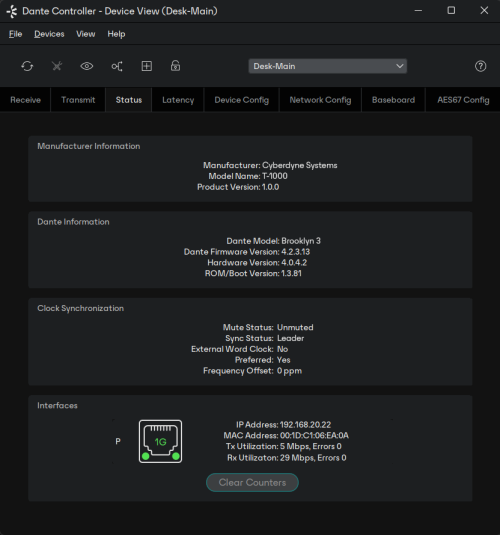Status Tab
The Status tab is used to obtain current information about a Dante device.

The tab is divided into sections. The information presented on this tab can be very useful when investigating networking or clocking issues in the system. The Refresh button  can be used to update this information if required.
can be used to update this information if required.
Note: Not all Dante devices support the display of all of this information.
Device Information
This provides the following general information about the device:
- Manufacturer: The name of the device manufacturer.
- Product Type: The type of device.
- Product Version: The product version.
- Software Version: The version of the manufacturer software running on the device.
- Firmware Version: The version of the manufacturer firmware running on the device.
Dante Information
This provides Dante-specific information about the device:
- Model: The Dante device type.
- Dante Firmware Version: The version of the Dante firmware running on the device.
- Hardware Version: The version of the hardware firmware running on the device.
- ROM/Boot version: The version of the ROM or bootloader.
Clock Synchronization
This provides the following information about device clocking:
- Mute Status: 'Muted' indicates that the device is has been automatically muted (due to a clock synchronisation problem, or because the external word clock is invalid). 'Unmuted' indicates that the device is not muted, and audio is flowing normally.
- Sync Status: 'Locked' indicates that the device is locked to the network PTP clock. 'Not Locked' indicates that the interface has not achieved lock with the network PTP clock.
- External Word Clock: 'No' indicates that the device has been configured to use the internal clock source. 'Yes' indicates that the device has been configured to accept an external word clock source. NOTE: If the Dante device is configured to accept an external word clock source, it is important to make sure that the host equipment has been configured to provide its word clock to the Dante device. Check your product manual for more information.
- Preferred: 'No' indicates that the card has not been set to preferred leader mode. 'Yes' indicates that the card is set to preferred leader mode.
- Frequency Offset: Indicates the offset from the network clock leader measured in parts-per-million.
Primary Interface
Provides the following information about the primary network interface:
- IP address: The IP address currently assigned to the interface
- MAC address: The Media Access Control address of the interface, associated with the Ethernet layer
- Tx Utilization: Shows the current total transmit bandwidth in use
- Errors: (on the same line as Tx utilization) shows the number of transmit Cyclic Redundancy Check (CRC) or packet errors detected since the device was last started
- Rx Utilization: Shows the current total receive bandwidth is use
- Errors: (on the same line as Rx utilization) shows the number of receive Cyclic Redundancy Check (CRC) or packet errors detected since the device was last started
Note: The Rx Utilization includes not only network traffic destined for the Dante device, but any other multicast or broadcast traffic received at this network interface.
Note: As a rule of thumb neither the Rx nor the Tx utilization should exceed about 85% of the link speed in order to guarantee good clock synchronization performance (links are full duplex).
The graphic also indicates the speed and connected state of the interface as follows:
|
|
Indicates that the link is operating at 1Gbps |
|
|
Indicates that the link is operating at 100Mbps |
|
|
Indicates that the link is not connected, or that there is an error. The IP address will read N/A, and Tx and Rx utilization will be 0 kbps. |
Clear Counters: Click this button to reset the packet errors history for the device.
Secondary Interface
This provides the same information for the secondary interface that is provided for the primary interface, as described above.
Note: The secondary network interface will only be displayed if the device supports redundancy.